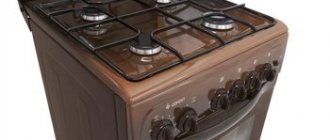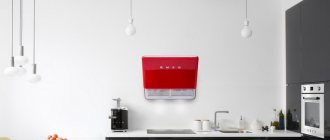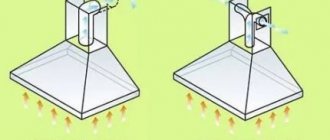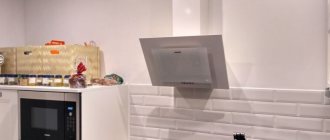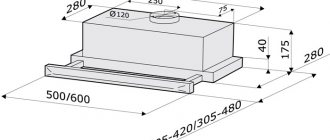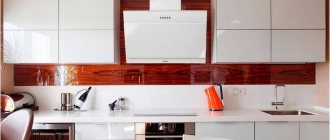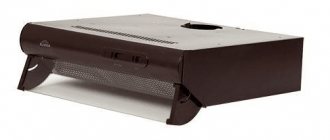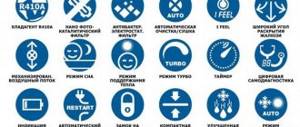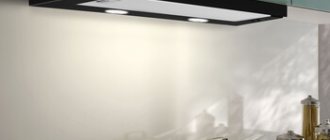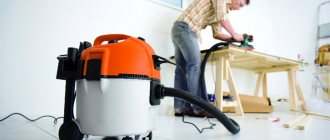Technique
0
6 719
Share
An air purifier for the kitchen is a device designed to process harmful impurities, purify indoor air, and preserve human health. Today, a lot of different models are produced, differing in technical characteristics, operating principle, and cost.
Polluted air purifier for kitchen
- Classification of devices
- Technical specifications
- Hood or air purifier: which is better?
- Installation
- Kitchen air purifier kits
- Care Tips
- Air purifier models
Difference in purpose
At first glance, in both cases we are talking about air purification. However, the nature of its contamination may be different. It’s one thing to have ordinary, heterogeneous dust; another thing is to have an atmosphere saturated with tiny fat droplets, fumes, and burning products, heated to high temperatures. In the first case, an air purifier, which can be equipped with humidification and ionization functions, copes with contaminants. In the second, the problem is solved by a household hood used in the kitchen. Hence the difference in the definition of these devices:
- An air purifier is usually defined as a device for cleaning dusty air in a room;
- A household hood is a device for eliminating smoke, fumes, burning, and other odors accumulated in the kitchen area that arise during the heat treatment of products.
How to choose the right hood
A proper hood should refresh the air in the room once every 5 minutes. The amount of air coincides with the cubic capacity of the kitchen. This figure is calculated by multiplying the area of the room by its height. It is necessary to make similar calculations if the height of your kitchen is very different from the standard (2.5-2.7 m). For ordinary apartments, just look in the passport for the recommended area for a given hood.
Note! The permissible excess power is up to 20% of the required one. A more powerful device will produce excess noise during operation and increase electricity bills.
Permissible noise level 45 dB. New models of kitchen appliances are characterized by a reduced noise level during operation, up to 40 dB. This parameter is also indicated in the technical data sheet.
The size of the hood is calculated by the area of the working surface. It should be equal to or overlap the area of your slab. A smaller hood will not be able to effectively capture updrafts.
The presence of several operating speeds allows you to effectively use the operating power of the device and save energy.
Lighting is a mandatory feature of any hood.
Additional features increase the cost of the device. These include:
- presence of a display;
- possibility of remote control;
- timer;
- setting automatic mode for periodic air purification;
- motion sensors to automatically start the device.
The best combination of price, quality and additional functions is offered by well-known European brands.
Design differences
The difference in purpose affects the design features, but first let’s talk about the similarities. Since both devices deal with air, there is a suction or exhaust element in the form of a fan with an electric motor. Often its cleaning is carried out according to a similar scheme: using a built-in filter system. Then the differences begin:
- most hoods use directional extraction and are mounted directly above the hob, preventing fumes from escaping beyond the working perimeter;
- the purifier is capable of taking air anywhere and does not require rigid fixation;
- a hood, like an air purifier, can operate in recirculation mode, but often the design operates in flow mode and requires a connection to the ventilation shaft;
- in the first case, the design provides fastening points that allow you to secure the device above the stove; in the second, the device is not tied to one place, although fastening connectors may be provided;
- exhaust equipment is equipped with more powerful filters that are capable of removing complex contaminants; purifiers are more diverse in the number of cleaning methods.
Difference between an air purifier and a hood and principle of operation
A purifier differs from a hood in the way it circulates air.
To clean air masses from fat, soot, and odors, several types of devices are used, including hoods and air purifiers. Their differences lie in the principle of operation and design features.
An air purifier sucks in dirty air, passes it through a bank of filters and returns it back into the room. Most hoods, on the contrary, take it outside or into the ventilation. Only a recirculating air purifier for the kitchen cleans the incoming flows and returns them.
The design differs in the degree of mobility of each product. The hood is a stationary appliance that is placed above the hob. To remove contaminants, additional pipe installation is required, which complicates installation. A kitchen filter above the stove instead of a hood is, in turn, more mobile, so it can be placed in any room in a suitable place. But maintenance of such a device is more expensive than that of a hood.
The devices also differ in their performance (hoods purify a larger volume of air), cost, noise level, and options.
Differences in cleaning methods
Both types of cleaning technology can operate in a recirculation version. In this case, the air taken from the room passes through the filters and returns in a renewed state, ready for reuse. With this cleaning scheme in the kitchen hood, odors and fumes are retained by carbon filters, while oily vapors are collected by a grease filter. In an air purifier, the circulating filtration system is more diverse. It can be:
- the same carbon filters,
- photocatalytic cleaning,
- thin HEPA filter,
- electrofiltration,
- water wash.
Flow operation scheme
An alternative to recirculating kitchen exhaust hoods is venting or flow cleaning. To work on this principle, it is necessary to connect to the ventilation shaft of a high-rise building or independently organize an outlet to the outside. This complicates the installation of exhaust equipment and requires the use of additional equipment. In this regard, a hood is more complex than an air purifier. It can simply be placed on a table in a room whose atmosphere needs cleaning and plugged into the network.
Additional functions
Depending on the cost category, both devices can be equipped with a range of additional functions. They provide the device with greater functionality and greater comfort for the user. The list of such amenities of both devices may include:
- an atmosphere control sensor with an automatic switch capable of activating the desired operating mode;
- timed shutdown, which allows you not to worry about timely shutdown of the device with the appropriate settings;
- a system for indicating the status of filters in audio and/or visual form, which allows for timely replacement and cleaning;
- remote control via a remote control, which makes the device as convenient as possible to turn on and configure, especially for those whose mobility is limited by a congenital or acquired illness.
Purifiers can be equipped with ionization and humidification functions. For flow-through exhaust systems, an important option is a check valve, which blocks the reverse flow from the ventilation.
Signs you need cleaning
Before you begin cleaning, you need to become familiar with the signs that indicate that your ventilation system needs to be cleared of debris.
These include the following:
- Dust formation. If the hood needs cleaning, dust or other small debris will accumulate near the exhaust vent.
- Raid. A dark coating on the surface of the grate indicates the need for cleaning. It may also become coated with particles of fat or soot.
- Fast heating of the room. If the ventilation system starts to work worse, the room warms up faster.
- Reducing drafts. With poor air circulation, the draft becomes much weaker.
Design and purpose of the ventilation system
Many people think that the air in the apartment is clean, but this is not the case. In fact, it absorbs various odors that come from the kitchen or from the street. It also contains dust particles, small lint, and even animal hair. Over time, the air accumulates a lot of dangerous bacteria and microorganisms that contribute to the formation of mold and mildew in the room.
Therefore, it is recommended to take care of organizing a high-quality ventilation system that performs the following functions:
- promotes the flow of clean air into the room;
- removing dust, bacteria, carbon monoxide and unpleasant odors from the room;
- normalization of humidity levels.
Advantages of a hood without outlet
A hood that does not require connection to a central ventilation shaft to operate can be called universal. It can be installed in any room.
Note! A recirculating hood is the only acceptable option in older houses equipped with gas stoves and gas water heaters. Flow hood here can cause reverse draft.
The main positive aspects of using a hood without outlet:
- retains heat in winter because it does not require forced ventilation and does not create drafts;
- compact, which allows you to install it in the smallest kitchen;
- provides clean air in houses with ineffective ventilation (which happens in old buildings);
- does not require complex installation - the main condition is the availability of an outlet;
- does not require maintenance, filters are replaced by the consumer.
We recommend that you read: Bathroom hood
The only disadvantage we can note is the need to purchase replacement fine filters. If you do not have the opportunity to install a flow-through hood, then a recirculation device would be an excellent choice.
Features of the hood
A hood is a type of ventilation system. It is designed to remove air. Many models also have an air recirculation function. Recirculation mode is sometimes called air purification mode, and it works by sucking air through one opening, passing it through filters, and then releasing the purified air back into the room through another opening. For these purposes, carbon or synthetic filters are usually used. A mesh metal filter is used to filter grease.
Important! The main characteristic of a hood is performance. It is measured in the volume of air per hour that it can pass through itself; in the characteristics, this parameter is indicated in units of m3/h.
Structurally, the hood is a device for air intake, in which an electric motor acts as a power element, and the main functional unit is a turbine or fan. With its help, air masses move. Most hoods have a suspended design and are attached either to the wall or to the ceiling. According to their shape, there are corner, wall, island (ceiling) and dome hoods.
Corner hood Wall model Island hood Dome version
In order for the hood to work, it must not only be mounted on a wall or ceiling, but also the air pipe must be routed into the ventilation duct. This may cause problems both for residents of private houses and, in some cases, for residents of apartments, especially if the house is old and built of brick. In such cases, the air duct is led through the wall directly to the street. In panel houses, ventilation ducts are usually provided by the design of the panels themselves. These factors complicate the installation of the hood and, accordingly, it is more expensive.
Hood installationAttention! If you have a gas boiler or water heater installed, problems may arise when using one ventilation duct, for example, the occurrence of reverse draft, and this is dangerous for property and even your life.
The industry produces hoods of various sizes, starting from approximately 50 cm wide, which allows it to be installed even in very small kitchens.
Advantages and disadvantages of hoods
Let's summarize and list the advantages and disadvantages of hoods.
Advantages:
- the ability to operate in two modes - air exhaust and air recirculation;
- wide range of constructive solutions, designs and sizes;
- the cost of the hood starts from 20-30 dollars;
- the noise level of most models is within 50-60 dB and does not cause inconvenience to users;
- if there is no recirculation function, then the filters do not need to be changed - the metal mesh filter is simply cleaned periodically. In models with a recirculation function, filters are changed depending on the frequency of use, from once a month or less.
Flaws:
- the need to install a pipe to exhaust air into the ventilation duct or to the street. This is not always possible and can also be expensive;
- Depending on the location of the stove, the length of the air duct may vary. To the point that you will have to lay it through the entire kitchen, and this will not only worsen the appearance of the room, but can also cause problems with the installation of a set of kitchen furniture and hanging cabinets;
- Warm air is drawn out of the room.
Principle of operation
Some kitchen air purifiers can only operate in exhaust mode, some only in circulation mode, but most models combine both principles.
If the air purifier operates in exhaust mode, then all exhaust air is completely removed from the room through the air ducts. If the model is set to recirculate, then the air is taken in, passed through a filter system, and then returned to the room.
As usual, each of these cleaning methods has its own pros and cons. The advantage of exhaust is that the air is completely removed - this is much more effective than cleaning through filters. On the other hand, this operating principle requires more serious installation, not to mention the fact that corrugated hoses do not look very aesthetically pleasing and take up a lot of space.
Models operating in recirculation mode take up much less space because they do not require any additional connections. They are very easy to install - just drive two self-tapping screws, hang the hood on it and plug the cord into the socket. But the efficiency of such purifiers is significantly lower, and owners will have to periodically spend money on replacing filters.
Filters for such hoods come in two types: universal and branded. Universal ones are a fibrous sheet impregnated with carbon, which absorbs unpleasant odors. This filter is placed on the grease filter and pressed with fasteners. The branded one is usually screwed directly onto the motor. Its carbon layer is much thicker, so it will purify the air better, but the cost of such a filter is higher. Depending on the model, filters must be changed every 3-6 months.
Features of air purifiers
An air purifier is a device designed to clean the air from odors, smoke, steam and dust. This means that it can only operate in recirculation mode. In this regard, for high-quality air purification, dense filters are installed, which causes an increased noise level.
The air purifier only works in recirculation mode
The air purifier does not require the installation of an air duct and its connection to the ventilation ducts. This makes installation of the device easier and, accordingly, reduces its cost. This means that the air purifier can be installed in rooms with any type of layout and wall structure.
Unlike hoods, air purifiers are produced in a wider range of designs; there are also devices for wall mounting, and for installation on the floor or on a table.
The following types of filters are distinguished:
- The pre-filter is made in the form of a fine mesh. Serves as a coarse filter to retain large particles, such as animal hair and other particles 5-10 microns in size. It also serves as a protection for finer filters;
- Carbon filters - these are often used in hoods. Another name is adsorption. The porous structure of coal absorbs odors, particles and gases. During operation, the pores of the filter are filled with microparticles, so they must be replaced periodically - approximately once every 3 months;
- HEPA filters. The name stands for High Efficiency Particulate Arresting. It traps particles up to 0.3 microns in size, namely: dust, wool, pollen, animal dander, dust mites. This type of filter is also used in vacuum cleaners. They are made from different materials, for example, disposable ones are made from paper and fiberglass, and washable models are made from fluoroplastic fibers and activated carbon;
- Photocatalytic filters. They decompose organic matter into harmless compounds under the influence of ultraviolet radiation on a photocatalyst;
- Air washing or water filtration. The principle of operation is to pass air through charged electrodes, after which charged particles settle on wet disks. The dust is washed off from them and falls into the pan. The advantage is that this type of filter does not require replacement;
- Electrofiltration. The principle of operation is the presence of electrodes between which an electric field is created and particles from the air that passes through them are retained in the filter. It is cleaned by washing with soapy water.
Air purifier filters For information! Air purifiers are usually equipped with two or more filters - this is necessary for effective air purification.
Advantages and disadvantages of air purifiers
Advantages of air purifiers:
- can be either suspended, similar to kitchen hoods, or stationary (tabletop), which allows use in any room;
- installation does not require connection to ventilation ducts;
- Warm air does not escape from the room.
Flaws:
- increased noise level;
- the need to replace most types of filters.
Types of filters in kitchen air purifiers
Kitchen air purifiers are often equipped with the following filters:
- fatty;
- air.
The first filter is a cassette consisting of several layers of plastic or aluminum. It can be washed with water. The air filter is designed for more complete cleaning and has a fibrous structure. It allows you to trap small particles.
In addition to the 2 considered, a number of models also contain a third, carbon filter. It is designed to eliminate odors. Air and carbon filters must be replaced at least once every 3 months. This is determined by the intensity of the equipment’s operation and entails additional, sometimes significant, costs.
Carbon filter for hood
Mobile purifiers can be equipped with a filter that operates on an electrostatic principle. Its essence lies in the fact that an electric field is formed around the electrodes, due to which they begin to attract particles in the air. A number of models contain a photocatalytic filter, which decomposes organic matter into simple, harmless compounds. Electrostatic and photocatalytic types are relatively expensive, but they do not need to be replaced.
To operate effectively, a kitchen air purifier must be equipped with at least two filters.
Types of Kitchen Air Purifiers
According to technical parameters, air purifiers are usually divided into three groups:
- exhaust;
- recirculation;
- mixed.
The exhaust system removes dirty air through a special hole and is an example of a classic hood, which has a typical shape (flat or dome) and is located above the gas stove.
Recirculation units process the air inside and release purified air outside. Impurities remain on the device filters. This type of mechanism allows you to make the air in the room clean and fresh, which has a beneficial effect on the atmosphere in the kitchen and the preservation of the external decoration of the walls and ceiling.
There are also devices that combine two types of mechanisms: recirculation and exhaust. Such devices are called mixed.
Types of Filters in Recirculating Air Purifiers
In turn, recirculation purifiers can have different types of filters:
- Mechanical in the form of a mesh for screening out large contaminants (specks, animal hair, hairs, etc.). “Coarse” cleaning is the first stage of filtration, and therefore such a mesh is included in any purifier.
- Electrostatic ones attract the smallest contaminants. They create a stable electric field around themselves, which helps attract charges of different polarities. Such filters do not even need to be changed, but only occasionally cleaned yourself.
- Photocatalytic ones help break down the molecules of large contaminants into the smallest harmless particles.
- Charcoal is necessary for drawing in and processing bad odors. But these filters cannot remove absolutely all odors, especially very strong or poisonous ones, such as carbon monoxide.
It is also customary to classify air purification equipment according to the type of installation and installation.
Often this parameter depends on the type of device mechanism. The following groups are distinguished:
- In the shape of a dome, which are placed above the stove. Most often, such devices have an exhaust type mechanism and exhaust air into special openings. These are standard hoods, for which space is usually calculated when developing an interior design.
- Appliances that are suspended above the stove. Hanging air purifiers usually have a recirculating mechanism.
- Devices that are built into kitchen appliances. Most often they have a mixed type of operating mechanism.
- Mobile devices. They are active only during air processing and are suitable for use throughout the apartment, as they can be easily removed and installed in a new location.
Kitchen air purifiers
GORENJE
KRONA GORENJE
GORENJE Island hood is designed for a stove located in the center of the kitchen
GAGGENAU models operate in both circulation and air exhaust modes
KRONA Doraj Wall Mounted Kitchen Air Purifier with Metal Filter, $369
KRONA Skarlett hood with halogen lighting and touch controls, $425
Tabletop hood AF2500 from TURBOAIR is installed next to the stove or built into the hob, $1200
Wall-mounted hood Stella from KRONA is available in aluminum and stainless steel, $435
MIELE Island hoods mounted to the ceiling
KRONA GORENJE The area of the exhaust hood must be equal to the area of the hob
The undoubted advantage of MIELE hoods is quiet operation (46 dB)
Built-in hood Kamilla from KRONA automatically turns on when the screen is pulled out, $120
Model IKD10700, KPPERSBUSCH, $2530
Wall-mounted hood Berta KRONA is equipped with slider controls and a decorative screen, $180
The DM8700 hood from AEG is equipped with a capacity regulator and is equipped with a remote control, $955
KPPERSBUSCH
Hood operation in air exhaust (a) and recirculation (b) modes
GORENJE The minimum distance from the hood to the hob is 65cm
SIEMENS
TURBOAIR
Hood design
GORENJE
MIELE Additional glass screen increases the air intake area
There is hardly a person who can honestly say that he doesn’t like to treat himself to something tasty at least occasionally. But sometimes, when preparing even the most delicious and refined dishes, we are forced to endure such “aromatherapy” that one inevitably wonders whether the game is worth the candle? But the matter is not limited to physical and psychological discomfort. Carcinogenic substances, an inevitable by-product of the combustion process, accumulate in the human body and have a detrimental effect on his health.
A kitchen air purifier, otherwise called a hood, can be a salvation from the above troubles. Devices may differ in parameters such as air purification technology, design, performance, noise level and, of course, price. So, let's try to figure it all out.
Air exhaust or recirculation?
There are two ways to get rid of smoke, soot and unpleasant kitchen “odors” - by removing contaminated air through the ventilation duct (air exhaust method) or by cleaning it using filters and then returning it to the room (recirculation method).
The first method is almost 100% effective: the costs of culinary production are simply banished from the kitchen. But installing a hood in this case will not be easy, since smoke and unpleasant odors need to pave the way from the exhaust device to the ventilation shaft or to the street (through the wall). This means that installation of chimney pipes will be required. Specialists will be needed to install the device. Payment for their services will average $20-30, for chimney pipes you will have to pay about another $10 per 1 linear meter, plus approximately $7 per 1 linear meter if the customer decides to hide the air duct behind a plasterboard structure.
Another important point: the hood creates a fairly strong outflow of air, which must be somehow compensated. The simplest solution is to open a window or window. Unfortunately, this is not always possible due to unfavorable environmental conditions, heat or cold outside. You cannot open the windows even if there is an air conditioning system in the apartment, since the supply air is an additional load on the unit. The most acceptable way to compensate for exhaust ventilation is to install special supply valves in window sashes or walls. Even when frying fish or onions, the air exhaust mode is able to ensure “clean breathing.”
As for the second method, recirculation, in this case the polluted air is passed through a filter system and returned to the room. This air purification option allows you to significantly save on installation: installing the hood will be extremely simple - in fact, it only needs to be attached to the wall (mounted in a kitchen cabinet) and connected to the electrical network, which will cost the customer $25-30. But, alas, even the most expensive and powerful device, working as recirculation, purifies the air only by 65-70%. In addition, the hood must be equipped with a carbon filter, which requires replacement every four to five months. As a rule, the recirculation air exchange mode is chosen when connecting the device to a natural ventilation system is impossible for some reason.
Almost all modern air purifiers can operate in both modes, but there are exceptions. Thus, relatively inexpensive and not very powerful built-in hoods can only function as recirculation.
Model Parade
Having decided on the most appropriate cleaning method, you can begin to choose the type of design that is best suited for the kitchen. So, what types of hoods are there?
Flat or mounted.
They are installed on the wall under a special kitchen cabinet (it should be shorter than the standard one) or without it. As a rule, the devices have not very powerful motors and operate only in recirculation mode (K704R and S651 from TURBOAIR, CMD98X from CANDY). It should be remembered that, even if the hood fits perfectly on the bottom shelf of the cabinet, it is necessary to bring the air duct outside, otherwise during operation the device will hum and vibrate, and the walls of the furniture will very quickly crack from the hot steam walking inside.
Built-in or integrated.
For example, K195SL601MW from KAISER, 51SLIinox from ELECTROLUX. The hoods are designed in the form of a wall cabinet above the stove, which allows you to save on body materials (with equal technical indicators, built-in appliances are 10-20% cheaper than island and wall-mounted ones). They can be equipped with two motors and have a retractable panel that significantly increases the air intake area (DHI655V from BOSCH, LI28030 from SIEMENS). This class of hoods is not much more expensive than wall hoods, but is more functional. Such models can operate both in recirculation mode and in air exhaust mode.
Tabletop.
They are installed next to the stove or built into the hob (VL051 from GAGGENAU, 115DDM from AEG), operate in two modes - recirculation and air exhaust. They can be an additional panel module, usually located between the stove and the grill. Such models are distinguished by high efficiency - the close proximity of the hood to the “source of pollution” ensures good quality of air purification.
Dome.
Mounted on the wall above the stove (Brio RD-BL-GMA90 from FABER, LunaZ900inox from SATA). Due to their external resemblance to fireplace chimneys, they are also called fireplace-type hoods.
Island.
They are attached not to the wall, but to the ceiling (DH1050IS from TURBOAIR and ZHC928IX from ZANUSSI). This is especially convenient if the stove is located in the center of the kitchen. Such hoods most often operate in air exhaust mode. The fact is that the very method of installing the device excludes the possibility of circulation - there will simply be nowhere for the air to escape. But technically, island hoods can usually operate in both modes.
Filters
TURBOAIR Air purification in kitchen hoods can be carried out using two types of filters - grease filter and carbon filter. The first traps the smallest particles of fat and soot, and is also used to protect the “insides” of the device and ventilation pipes from contamination. On off-road models, it can be made of non-woven fabric or padding polyester, in which case it will need to be changed regularly. A filter made of aluminum or steel is much more convenient. It is enough to wash it occasionally with warm water and any liquid detergent (by the way, a dishwasher can do this job quite successfully). The second filter, carbon, captures organic contaminants: gases, fumes, unpleasant odors - everything that we call kitchen waste. This filter cannot be cleaned; it must be replaced within the time specified by the manufacturer (usually every 4 months).
Size matters
An important factor is the dimensions of the hob above which the air purifier is installed. The hood will work effectively only if its umbrella completely covers the surface of the stove. Obviously, the most popular among buyers are models with umbrella widths of 60 and 90 cm, that is, equal to the width of standard hobs. Some difficulties may arise if the stove has a width of more than 90 cm - hoods with umbrellas of 120 cm or more are slightly: AH400-131 from GAGGENAU (90136 cm), DA252-2 from MIELE (50120 cm). In special cases, for example when the stove is made up of several cooking modules, you can use a combination of wall-mounted and tabletop appliances.
Performance
When choosing a suitable device, you should take into account another indicator - performance. It is measured by the volume of air that the hood can pass through itself per unit of time. It is calculated in m3/h. Low-power devices pump 200-300 m3/h, more “hard-working” ones (DA200 from MIELE, 9060D from AEG) - about 500-750 m3/h. The AH400-131 model from GAGGENAU with a capacity of 1200 m3/h stands out. Such a big difference in performance is due to the fact that the air purifier must match the size of the room in which it will be installed. The average performance of a hood for a kitchen of a certain area can be found in the table on the left. If the room has non-standard dimensions, you can do the calculation yourself using the formula: SH131.3; where S is the kitchen area; H - ceiling height; 13 - sanitary standard for air exchange rate per hour; 1.3 is the minimum safety factor required to take into account the number of floors of the building, the length and bends of the air duct from the hood to the ventilation hole, the density of filters, etc.
It is important to remember that the maximum hood performance indicated in the data sheet corresponds to operation in the air exhaust mode. Recirculation is associated with an additional load on the fan, since the air must be driven through another carbon filter. In this case, there is a rather noticeable drop in productivity - by 30-40%. For example, the maximum productivity of the DA217-1 (MIELE) model with free air exhaust is 705 m3/h, and with recirculation it is 480 m3/h. Therefore, if the device will operate recirculating, this indicator must be clarified.
Many modern hoods are equipped with performance regulators, which allow you to adjust the volume of pumped air to a specific situation.
| Kitchen area, m2 | Hood capacity at ceiling height in m, m3/h | |||||
| 2,5 | 2,7 | 3 | 3,2 | 3,5 | 4 | |
| 6 | 234 | 253 | 281 | 300 | 328 | 374 |
| 7 | 273 | 295 | 328 | 349 | 382 | 437 |
| 8 | 312 | 337 | 374 | 399 | 437 | 499 |
| 9 | 351 | 379 | 421 | 449 | 491 | 562 |
| 10 | 390 | 421 | 468 | 499 | 546 | 624 |
| 11 | 429 | 463 | 515 | 549 | 601 | 686 |
| 12 | 468 | 505 | 562 | 599 | 655 | 749 |
| 14 | 546 | 590 | 655 | 699 | 764 | 874 |
| 15 | 585 | 632 | 702 | 749 | 819 | 936 |
Additional functions
Hoods are equipped with a set of additional functions designed to make the “kitchen watch” as comfortable as possible. The first and main option is lighting. The simplest and cheapest option is ordinary incandescent lamps (KF61WH from ARDO). In more advanced and expensive models, you can find halogen lamps that can bring lighting closer to natural (EFC935X from ELECTROLUX, IS50290XS from KAISER), or fluorescent lamps, which are highly economical and have a long service life (AH400-131 from GAGGENAU and DA216-2 from MIELE) . In addition, in some devices the lighting can be adjusted. Thus, the LC89950 from SIEMENS provides functions for changing the intensity of the light flux (Soft Light) and adjusting the size of the illuminated area (Dimm). Air purifiers from MIELE (DA259-2, DA252-2), AEG (9050DM Katamaran), and GENERAL ELECTRIC (JV750SISS) are also equipped with similar systems. In the DN1021NST model from TURBOAIR, the light does not light up instantly, but smoothly. For ease of use, the device is equipped with a remote control. By the way, the control of the hood can also be different - slider (lever), push-button, pseudo-touch (responsive to light pressure) and touch.
Among the optional, but certainly useful functions is the interval switching system (in the hoods LC75955 from SIEMENS and AH400-131 from GAGGENAU), which starts the fan once an hour at low power, which creates a constant flow of air into the room. This may be relevant if the natural ventilation system does not work well.
The residual stroke button (in models DKE995B, BOSCH; DA289, MIELE) ensures that the fan operates for approximately 10 minutes after the hood is turned off. Thus, even “odors” that accidentally linger there are removed from the kitchen.
The protective shutdown sensor (on devices LC75955, SIEMENS; EFC009X, ELECTROLUX) ensures that the hood does not “overwork”, and the grease filter contamination sensor (on the DHI665G, BOSCH model) will tell you that it’s time to clean the filter.
Some devices also have unique abilities. For example, the control function from the stove using an air density sensor, implemented in the LC75955 (SIEMENS) model, is interesting. An ultrasonic density sensor determines the degree of contamination of the heated air and automatically sets the operating mode for the hood. Another one-of-a-kind model, the AH 600 from GAGGENAU, is equipped with a built-in air curtain: the fan diverts part of the air into a special channel located on the front panel, and the resulting flow blows the hood over the stove. As a result, the steam rising from the prepared dish rushes into the bell of the device.
Safety precautions
A kitchen hood differs from conventional forced ventilation systems primarily in that it deals with heated and highly polluted air. When working with such an aggressive environment, the device must be protected as much as possible. First of all, you should pay attention to the height of the umbrella. The lower the hood is mounted above the stove, the better it will capture fumes and odors. But do not forget that if this distance is too small, then there is a danger of overheating of the device and even its fire, because grease and soot inevitably accumulate on the filters, which can ignite. You need to be doubly careful if the hob is gas - a fire can break out from an accidental spark. In any case, the distance between the air purifier hood and the hob should be at least 65cm for electric stoves and 75cm for gas stoves. The hood must be grounded. Unfortunately, our electrical network is not very stable, and sudden voltage surges do not have the best effect on the performance of the device. If the device is grounded, then you can be sure that a breakdown of the electrical insulation on the umbrella will not lead to dire consequences.
Silence is the key to peace
The undoubted advantage of the hood is its quiet operation.
It is important to remember that this indicator directly depends on the power of the device: the higher it is, the louder it works. Among the “quiet” models, the leaders are 2600Dm from AEG (44dB at a productivity of 520m3/h) and AH900 from GAGGENAU (49dB at 660m3/h). Almost all samples of well-known brands comply with European quality standards, so even relatively inexpensive models have a noise level that does not exceed 70 dB. Nikolay Meshchaninov, Director of Marketing and Advertising, TURBOAIR SpA Representative Office
“If it is assumed that the hood will operate in air exhaust mode, you need to pay attention to how the air duct is laid. Bends, turns, and narrowing of the pipe reduce the efficiency of the device. The fact is that the hood must pass a certain volume of air through itself per hour. Extra obstacles in the flow path cause it to “pick up speed”, creating additional vibration and noise.
The material from which the duct pipes are made also matters. Pipes made of thick cardboard are cheap, but short-lived. Foil is more practical, but it can rustle quite loudly during operation of the device. Perhaps the most acceptable option is PVC boxes. Their rectangular shape allows you to lay pipes under a suspended ceiling or hide them behind kitchen cabinets, or even leave them in plain sight - the light plastic will not be conspicuous and will not disrupt the interior design.”
The law is harsh, but the law is the law
Installing a kitchen hood operating in air exhaust mode confronts the consumer with another problem - ventilation of residential premises.
VSNiP 2.08.01-89* “Residential buildings” (clause 3.2.) says: “In residential buildings, heating and ventilation with natural impulse should be provided...”. Appendix No. 4 states: “...the exhaust from the kitchen is at least 60-90m3/h (depending on the type of stoves).”
If the apartment has a ventilation duct, then warm air through it rushes up and out. And the colder it is outside, the more air is removed into the channel. In summer, the natural impulse simply does not work, and may even have the opposite effect - the so-called overturning of the ventilation. Therefore, the new standards of Moscow (MGSN 3.01-96) contain the following paragraph (clause 5.9): “In residential buildings, the installation of supply and exhaust mechanical ventilation or air conditioning is allowed.”
The brevity of this formulation allows it to be interpreted as the possibility of creating an exhaust system with a fan that removes air from a separate room. In other words, the legality of connecting a kitchen hood to the ventilation system can somehow be proven. But from a practical point of view, things are not so good. Unfortunately, our ventilation ducts are not very suitable for these purposes. In residential buildings, the natural air exchange system is designed for a certain volume of air removed under natural conditions, which means a free flow of air and its unimpeded escape into the ventilation hole. Based on this situation, air ducts and shafts of the appropriate section are manufactured.
Such a design system does not involve the installation of a draft stimulator, such as an exhaust fan. The volume of air drawn through a kitchen umbrella is quite large (on average 250-600 m3/h), and this can lead to a violation of the aerodynamic balance. And if air purifiers are installed in several apartments at the entrance, there is a risk that the entire natural ventilation system will be blocked. However, even when turned off, the hood creates barriers to air movement. A special ventilation duct designed for kitchen hoods is designed to solve this problem. Some houses under construction are equipped with it, but, alas, only of the elite type.
All of the above does not mean that installing a hood in a city multi-storey building is impossible in principle. As a last resort, you can always purchase a model with either a recirculation mode or with adjustable performance, or with air exhaust to the street through a wall valve.
In cottages and country houses, the problems of installing air ducts are significantly simplified - builders have much more room for maneuver, and the troubles that may arise from exhaust hoods will not extend to the neighbors’ homes. But even in this case, it is useful to provide two independent ventilation ducts in the kitchen: one for general ventilation, the other for exhaust.
| Manufacturer | Model | Width, depth, height, cm | Max. productivity, m3/h | Design Features | Price, $ |
| AEG (Germany) | DL 6250-ml | 54,816,230,2 | 420 | Built-in. Modes: circulation and air exhaust. Lighting - incandescent lamps. Smooth gear shifting | 281 |
| 8160 DM | 6047135 | 420 | Wall-mounted. Modes: circulation and air exhaust. 3 stages of performance adjustment | 400 | |
| ARDO (Italy) | KF 61 WH | 604815 | 195 | Built-in. Modes: circulation and air exhaust. Lighting - incandescent lamp | 45 |
| AR 60 IX | 60 (90)2949 | 680 | Wall-mounted. Modes: circulation and air exhaust. Halogen lighting. Aluminum filters | 257 | |
| BOSCH (Germany) | DHL545S | 533825,5 | 500 | Built-in. Modes: circulation and air exhaust. Halogen lighting. Adjustable performance | 150 |
| DHI655V | 59,82853,4 | 720 | Built-in. Modes: circulation and air exhaust. Retractable screen | 400 | |
| CANDY (Italy) | C MD 94 | 9048,550 | 700 | Wall-mounted. Modes: circulation and air exhaust. 2 halogen lamps. Turbo motor 140W. Touch control. Indicator of contamination of grease and carbon filters. Off timer | 550 |
| CATA (Spain) | Luna Z900inox | 9097,550 | 880 | Fireplace type. Modes: circulation and air exhaust. Halogen lighting. Slider control | 533 |
| ELECTROLUX (Sweden) | NF 51 SLI inox | 155052,3 | 200 | Built-in. Modes: circulation and air exhaust. Acrylic grease filter | 81 |
| EFD 280 X | 14,55160 | 450 | Tabletop. Modes: circulation and air exhaust. 2 performance levels | 130 | |
| FABER (Italy) | Brio RD-BL-GM A 90 | 9078,5-10050 | 420 | Dome. Modes: circulation and air exhaust. Lighting - incandescent lamp. Color - gray, blue, red | 484 |
| GAGGENAU (Germany) | IS 502 90 XS | 908490 | 700 | Ostrovnaya. Modes: circulation and air exhaust. Halogen lighting. Remote control | 930 |
| KAISER >(Germany) | K 195 SL 60 1 MW | 605015 | 230 | Built-in. Modes: circulation and air exhaust. Metal filter | 60 |
| K 29 SL 60 1MBL | 6082,350 | 400 | Wall-mounted. Modes: circulation and air exhaust. 3 operating speeds. Metal grease filter. Telescopic pipe (height 82.3-123.8cm) | 300 | |
| MIELE (Germany) | DA 249-2 IX | 9084 (109)50 | 690 | Wall-mounted. Modes: circulation and air exhaust. Keys with LED indicators. Operating time counter, individually programmable. Combination of stainless steel or aluminum with glass. Tempered glass bell and visor | 1460 |
| KRONAsteel (Italy) | Stella | 6090 | 650 | Wall-mounted. Modes: circulation and air exhaust. Touch control | 496 |
| SIEMENS (Germany) | LI28030 | 59,82835,4 | 720 | Modes: circulation and air exhaust. Two fans. Retractable screen | 220 |
| LC89950 | 1089078 | 590 | Wall-mounted. Modes: circulation and air exhaust. Filter clogging indicator | 903 | |
| ZANUSSI (Italy) | ZHC 615W | 1006049 | 450 | Wall-mounted. Modes: circulation and air exhaust. Lighting - incandescent lamps. 3 performance levels | 180 |
| TURBOAIR (Italy) | ES6000 | 60 (90)1049 | 320 | Mounted. Modes: circulation and air exhaust. Lighting - fluorescent lamps. Housing - stainless steel, white, black, brown | 128 |
The editors thank the representative office of TURBOAIR SpA for their assistance in preparing the material.
The nuances of installing air purifiers
As mentioned above, the installation of devices with recirculation and flow operating principles is different. You should select a location for the hood so that you can easily connect an air duct to it and then connect it to a common ventilation shaft. Ideally, it is recommended to purchase an air purifier in combination with kitchen furniture so that its model fits into the design of the room.
The installation process is simple, but a number of nuances should be taken into account:
- you need to calculate in advance the location of the outlet from which the installed device will receive power, so that its wire is not stretched and does not come into contact with the heated parts of the stove;
- You need to install the air purifier before arranging the kitchen furniture, in order to be able to pre-determine the direction and area of its action, and conveniently arrange all the components of the set around the room.
Installation diagram of a flow cleaner
The optimal distance of the purifier from the stove is 0.75 m, which meets fire safety requirements. This arrangement allows the device to draw in all fumes emanating from the stove.
It is not recommended to connect the device through an extension cord. The best option for the location of the outlet is to place it hidden in the cabinet at the level with the purifier.
How to Install a Kitchen Air Purifier Above the Stove: Construction Tips
An important role when installing a circulation hood is played by its position relative to other interior items and household devices. you figure out how to properly install an air purifier :
⇒ The air purifier must be hung before furniture is installed. This will allow you to orient the direction of its work to the area where the stove itself is located, as well as combine all the elements on the wall.
⇒ It is necessary to think in advance about the place where the socket into which the device will be connected will be installed. It is worth remembering that the wire should not sag, be in a constantly tense state, or be in close proximity to the heating device. The best option is to place the socket at a level with the device itself in the cavity of the cabinets.
⇒ An air purifier for a kitchen above the stove should be mounted at a certain height from the flame. The most optimal distance indicator is 75 cm. With this arrangement, the device captures the entire volume of fumes that come from the stove and is not subject to adverse thermal effects.
The most significant positive point when installing an air purifier is that it is an independent device. Unlike a hood, it does not require the organization of additional exhaust channels or connection to a general ventilation system, but can only work if there is an outlet. The process of installing the air purifier itself is no more complex than the work of hanging cabinets - all you need is a few screws and a drill.
Comparison of the distinctive parameters of an air purifier and a hood
To consolidate the above, let’s compare hoods and air purifiers according to a number of parameters.
Purpose
The hood is designed to remove air outside the room, but most models can also operate in recirculation mode. Air purifiers operate only in recirculation mode , but due to their design features, they cope with this task better than hoods.
Air recirculation scheme
Principle of operation
The hood works by sucking odors, steam and smoke out of the room. With the help of an electric fan, air flows into the ventilation ducts.
The air purifier passes air through a group of filters and is not connected to ventilation. The performance, noise level and quality of operation of the device depend on the quantity, quality and condition of the filter elements.
An air purifier passes air through filters
Design differences
Structurally, air purifiers differ from hoods in the following:
- The air purifier does not have a channel for connecting to ventilation;
- Installing a hood is more difficult and requires the ability to vent air outside;
Hood installation is more complicated - The hood usually has 1 or 2 filters (mesh and carbon), and the air purifier has 2 or more;
- Due to the filter elements, the throughput of the air purifier is worse, so it is more difficult for air to pass through it, hence the increased noise level of these devices.
Cleaning methods
The filter elements of hoods and air purifiers must either be replaced or cleaned. However, in hoods there are fewer elements and the carbon filter must be replaced, while the mesh filter can simply be washed. While half of the filters used in air purifiers are disposable. This leads to the problem of increased operating costs for the air purifier.
The mesh filter can be simply washed
Flow hood
The device is placed directly above the stove and, when operating, draws in steam, smoke, and in general everything that is commonly called kitchen fumes. Through the air duct, all contaminants and combustion products are discharged outside the room along with the air.
Full flow hood
Since there is an outflow of air in the kitchen, it is necessary that fresh air from the street enters the apartment during operation. Therefore, do not forget to open windows and doors. After all, the air must constantly circulate (air thrown into the street must be replaced by fresh intake). If everything is hermetically sealed, and air from the street is not allowed to enter, then it is possible that while the hood is operating, air from neighboring apartments will begin to flow into your apartment. You probably won't like it.
It is believed that with the correct ratio of hood power and cubic meters of room, per hour of operation of the device, the entire volume of air in the kitchen should change from 10 to 12 times. Agree that this is the most complete update of the kitchen air, provided, of course, that the air outside meets environmental standards.
The flow-through hood has a filter (although there are also hoods without it). But its presence does not affect the quality of air purification in the room (as, say, in a circulation purifier), since this air is still discharged into the chimney and then into the street. Here the filter is needed only to protect the fan motor from sticky soot and grease residue.
grease filter
From time to time, the filter must be washed and grease removed with a degreaser (either manually or using a dishwasher). If this is not done periodically, a filter clogged with greasy dirt will stop letting air through. The device will not be able to perform its main task. The load on the engine will increase and it may fail prematurely.
The method of 100% air replacement should appeal to everyone. Who can be against fresh air from the street? But the problem is that in winter, not everyone wants to lose heat in the house, especially if there is a problem with heating. After all, when it’s frosty outside, we try by all means to provide ourselves and our loved ones with a comfortable temperature in the apartment and pay money for it. This means that when we expel the air heated by heating into the chimney, we also throw our money there. In this case, it may be better to have a circulating kitchen air purifier at home.
Technical specifications
Each air purifier for the kitchen has its own technical parameters. To determine whether a device is suitable for a particular room, you need to find out:
The flow-through appliance throws kitchen fumes and soot out
- Working blade size;
- Performance;
- The height of the noise.
Working blade size
The size of the working surface of a stationary air purifier must be greater than or equal to the size of the plate. There are three standards for hoods: 60, 90 and 120 cm. Some owners install cooking appliances in the center of the kitchen or form an island from several surfaces. In any option, it is necessary that the air purifier controls the entire slab surface.
Performance
Productivity is the amount of air mass that the device passes through in one hour.
The calculated productivity of the air purifier must be higher than that specified in the technical data sheet.
To determine the calculated indicators, the volume of the room is multiplied by 12 (the air exchange rate for the kitchen) and by 1.3 (the level of air pumping through ventilation in a multi-story building). In one-story houses, the last indicator can be neglected.
Noise
Air purifiers for the kitchen cannot be called low-noise devices. The maximum noise level is 65 dB, but in general, kitchen air purifiers are noisy at 55 dB. For comparison, the same indicator for a refrigerator is 45 dB, and the centrifuge for a washing machine produces 68 dB.
Type of hood in the kitchen interior
In order to select an air purifier, it is necessary to determine the intensity of pollution and the required functionality. The main requirement for the device is to clean the air and remove harmful substances from it. The device does not require the installation of ionizers or oxygen enrichers, which will only complicate its maintenance.
Main causes of blockages
There are six reasons why blockages in the ventilation may appear.
Accumulation of dust, dirt, grease
The main reason why the ventilation system begins to function worse is the accumulation of particles of grease, dirt and dust. All these contaminants gradually accumulate on the surface of the walls of the shafts or air circulation channels.
Most often, pollution accumulates due to too narrow channels through which waste oxygen moves from the bathroom, kitchen or living rooms.
Moving inside the system, all the particles of garbage gradually accumulate. Over the years, the mud layer increases, causing air to move much more slowly. Therefore, experts recommend periodically cleaning the ventilation system to prevent debris from accumulating in it.
Brick collapse
The most serious reason that leads to poor air circulation is collapsing brickwork. It is from brick that the ventilation shaft is constructed in many houses. To fix this problem, you will have to clean and repair the broken shaft. However, sometimes it is difficult to cope with such a problem on your own, and therefore many have to live with a damaged ventilation system.
Small animals and birds
Often birds and other small animals get inside the ventilation hood. This happens in winter, when lukewarm air begins to rise from exhaust pipes, emanating from bathrooms or kitchens. Warm air currents attract birds, and because of this, they fly up to the ventilation holes and begin to sit on them to warm up a little. Most often, sparrows and pigeons flock to warm themselves, which are most numerous in cities. Some of the birds sitting on the pipes fall into the ventilation, which is why it begins to work poorly.
Another reason why birds fall into pipes is because they are trying to build nests in them. Therefore, there may be chicks at the bottom of the mine, and not just adults.
Kitchen hood
Sometimes when installing a kitchen hood, people cut it into the ventilation duct. This should not be done, since conventional ventilation is designed to pass through about 90 cubic meters of air per hour. This figure is more than ten times less than the performance of most modern models of exhaust structures. Therefore, when a hood is installed inside the ventilation shaft, excess pressure is created, due to which air flows begin to be pushed into neighboring apartments.
Before installing a hood in the kitchen, you need to consult with a specialist so that he can explain where it can be installed.
Replacing wooden windows with plastic ones
It is no secret that for the normal functioning of the ventilation system, a constant supply of fresh air is needed. If it is not there, air circulation will deteriorate significantly. The use of a new sealed plastic double-glazed window impairs the flow of air into the room, which leads to periodic fogging of the glass and the appearance of traces of mold on the surface of the walls. How to quickly wash blinds at home, the best folk and chemical remedies
To avoid problems when using plastic windows, it is necessary to periodically ventilate the room even in winter. Some people recommend installing wooden windows, but they retain heat less well.
Seasonal features
There are also seasonal features that affect the quality of ventilation. For example, in winter it works well and without interruptions, but in hot weather its performance can deteriorate significantly. This is due to the fact that in winter the temperature difference between outside and inside is too high.
In summer, the temperature difference is not so significant, and therefore air ventilation becomes worse. To normalize it, you will have to open windows or install forced ventilation devices for better air circulation.
How to upgrade your ventilation system
Sometimes in old houses even cleaning does not help improve the performance of the exhaust structure. Therefore, it is necessary to increase air circulation in other ways. There are methods available to improve ventilation. For example, you can install modern double-glazed windows that have a micro-ventilation function. Such windows promote air circulation in the room. You can also use special fans to improve air flow. Such exhaust devices are installed in the bathroom, toilet or kitchen.
Where to go if you can’t clean it yourself
It should be noted right away that cleaning the ventilation in an apartment building is the responsibility of a special organization that has entered into an agreement with the management company. It is prohibited to clean the vertical ventilation shaft yourself. And it is impossible to do this qualitatively with improvised tools and devices.
Therefore, you need to come to the office of the management company and leave a written statement, indicating the entrance number and house number. The thing is that one vertical ventilation shaft is often installed per entrance. Therefore, it will be easy to search for it if the entrance number is indicated.
Specialists who arrive on call must first take measurements of the air speed in the ventilation system. One froze from the side of the apartment, the other from inside the mineshaft. After which it is determined what activities will be carried out. By the way, in addition to cleaning, it is proposed to carry out disinfection or repair.
Please note that the question of who should clean precisely determines the responsibilities of the parties. That is, the management company does not do this itself. She simply monitors the requirements of the residents of the apartment building and their implementation by her employees or persons with whom there is an agreement to carry out certain events. But residents must demand the work be completed from the management company.
